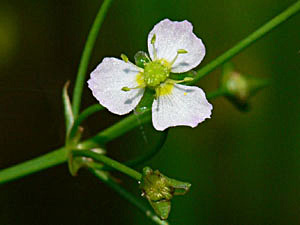
medicinal herbs
Great Water Plantain
Alisma plantago-aquatica

Herb: Great Water Plantain
Latin name: Alisma plantago-aquatica
Synonyms: Alisma parviflorum, Alisma subcordatum, Alisma triviale
Family: Alismataceae (Water-plantain Family)
Medicinal use of Great Water Plantain:
The leaves are antibacterial, anticholesterolemic, diaphoretic, diuretic, hypoglycaemic and hypotensive. They are used in the treatment of cystitis, dysentery, renal calculus, gravel etc. The fresh leaf is rubefacient. It is used in the treatment of leprosy and is also applied locally to bruises and swellings. Dried stem bases eaten, or grated and taken with water in treating digestive disorders such as heartburn, cramps and stomach flu. The powdered seed is an astringent, used in cases of bleeding. The seed is also said to promote sterility. The root has a wide range of medicinal uses. It is antibacterial, anticholesterolemic, diuretic and hypotensive. It is said to lower blood pressure, cholesterol and blood sugar levels whilst it also has an antibacterial action on Staphylococcus, Pneumococci and Mycobacterium. The root is used in the treatment of oliguria, oedema, nephritis, acute diarrhoea, cholesterolaemia and fatty liver. It has been thought of as a cure for rabies, though this has not been substantiated. The whole plant is believed to promote conception. The root is harvested before the plant comes into flower and is dried for later use. A homeopathic remedy is obtained from the fresh root.Description of the plant:

Plant:
Perennial
Height:
90 cm(2 feet)

Flowering:
June toAugust
Habitat of the herb:
Ditches, damp ground and shallow pond margins in water up to 15cm deep.Edible parts of Great Water Plantain:
Root - cooked. Rich in starch. Caution is advised, the root is acrid if it is not dried or well cooked before use. Leaves and petioles - must be thoroughly cooked. They require long boiling and have a salty flavour.Propagation of the herb:
Seed - best sown in a cold frame as soon as it is ripe. Place the pot in about 3cm of water to keep the soil wet. Pot up the seedlings when large enough to handle and keep in the cold frame for the first winter, planting out in late spring. Division in spring or autumn. Fairly easy, the divisions can be planted straight out into their permanent positions.Cultivation of Great Water Plantain:
Ditches, damp ground and shallow pond margins in water up to 15cm deep.Known hazards of Alisma plantago-aquatica:
The fresh leaves and roots are toxic but the toxic principal is destroyed by heat or by drying.Plant information taken from the Plants For A Future.
